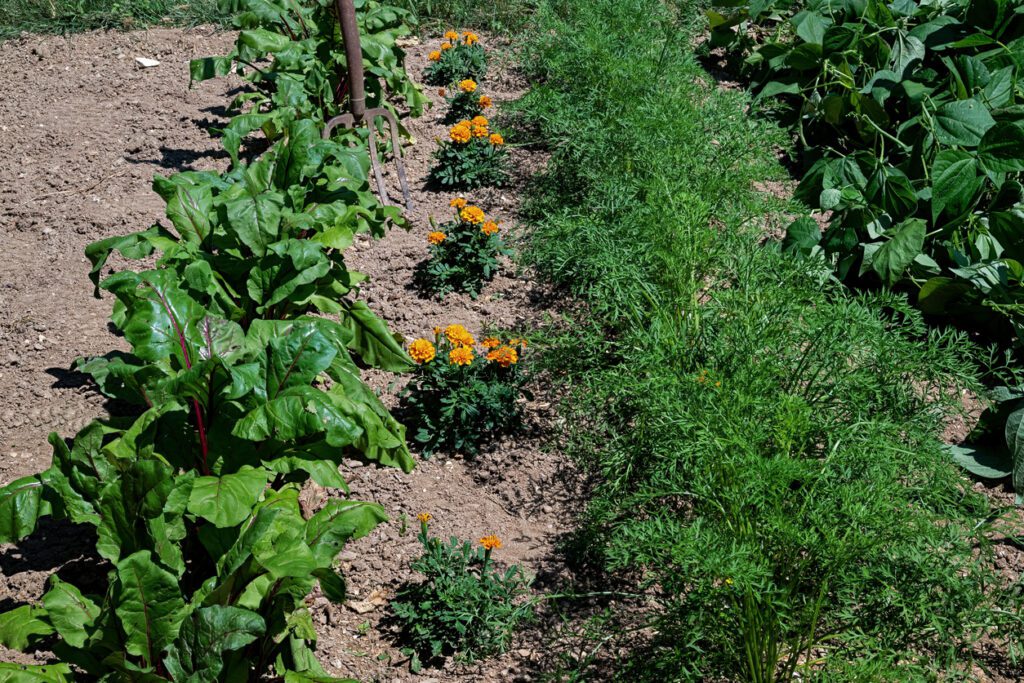Imagine stepping into a garden where every leaf whispers secrets of harmony and every flower blooms in the camaraderie of its neighbor. This isn’t the stuff of fairy tales—it’s the art of companion planting, a practice as old as the hills upon which gardeners have toiled for generations.
What are Companion Plants?
Companion plants are the friends at a party who bring out the best in each other. They’re the diverse cast of plants that gardeners group, creating a symphony of mutual support. It’s a botanical buddy system where each plant contributes something valuable to its neighbor, whether it’s shade, nutrients, or even an earnest stand against the unwanted pests that lurk in the underbrush.
When I began to dabble in gardening, the concept felt like decoding an ancestral whisper, a secret passed down through time. It spoke of an understanding that in nature, as in life, we thrive best when we support one another.

The Purpose They Serve
Companion planting always felt like a dance; it’s like knowing who will spin you around the floor best. Some plants, like marigolds, take the lead, releasing a scent that wards off nematodes and other pests. Others, like basil, might look different from the tough ones in the crowd. Still, something magical happens when planted next to tomatoes. Not only do they improve the flavor, but they also repel flies and mosquitoes. There’s a charm in knowing that climbing peas love the sturdy structure of corn stalks or that carrots and leeks are kindred spirits, each repelling the other’s sworn enemies. Companion planting isn’t just helpful—it’s a tale of relationships, a storytelling of living in cooperation.
Then there are nasturtium flowers, whose bright faces attract pollinators to shy, blooming vegetables, ensuring their fruits are set. Like dill and fennel, herbs play the protectors, inviting beneficial insects to their feathery foliage.
In my garden, I’ve loved watching nectar-rich flowers create a sanctuary for bees and butterflies. It feels like setting the table for a feast, where the guests, in turn, pollinate your crops. Each season, I explore more combinations, watching the ebb and flow of life amongst the rooted dwellers of my little plot.
Examples in the Garden
Take, for instance, the classic ‘Three Sisters’ planting method—corn, beans, and squash living in unity. The corn provides a ladder for the beans to climb; the beans fix nitrogen in the soil, feeding their siblings; and the squash, spreading its broad leaves, creates a living mulch that conserves water and deters weeds. It’s a triumvirate of growth, each plant a pillar for the others.
Every season, I set the stage for a new set of companions to play their roles. Strawberries and spinach share a bed, the leafy greens protecting the soil as the strawberries creep under a leafy umbrella.
Reflecting on Nature’s Lessons
The garden has taught me that collaboration goes beyond the visible. It’s in the subtle exchanges below the soil—nutrients, and signals passed in secret networks of fungi and roots. Companion planting is a lesson in subtlety and planning, in knowing that sometimes, the most beautiful relationships are the ones you plant side by side.
Today, as I stroll through my garden, I see more than plants. I see allies and guardians, nurturers, and friends. It’s a living mosaic where each piece plays part of a larger story—a story of harmony and togetherness that only nature could write so well.
Conversely, companion planting can transform your garden into a tableau of ecological balance and beauty. It’s not just about the harvest—it’s about crafting a narrative where each plant, like us, finds connection and purpose in the company of others.
References:
Invite Three Sisters Into Your Vegetable Garden | Garden America. https://www.gardenamerica.com/invite-three-sisters-into-your-vegetable-garden/
Thank you for reading this blog post. If you have any questions or comments, please leave them in the Comments section below.
Copyright © 2019. I Don’t Know All The Answers, Nikki Mastro.
All of my photographs and documents are Copyrighted.
The pictures included in this blog post are from the iStock.com library
No part of this website, including text, photographs, and documents, may be reproduced, stored in a retrieval system, or transmitted in any form or by any means without written permission from the copyright holder. All unauthorized use is strictly prohibited. If you choose to copy or share any information from my site, you must provide a link to the source. I appreciate your cooperation.
For further information concerning “I Don’t Know All The Answers.”
– Blog: https://www.idontknowalltheanswers.com
– Facebook: https://www.facebook.com/Nikki.L.Mastro
– Instagram: https://www.instagram.com/i_dont_know_all_the_answers/
– Linkedin: https://www.linkedin.com/in/nikki-mastro-05455a3a/
– Youtube Channel: https://www.youtube.com/@idontknowalltheanswers1954

